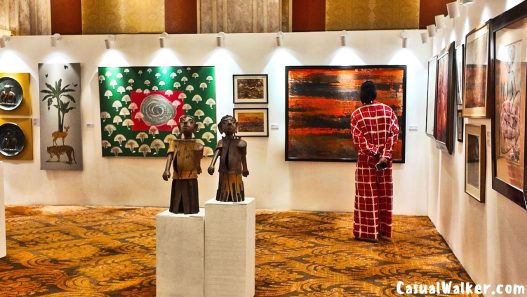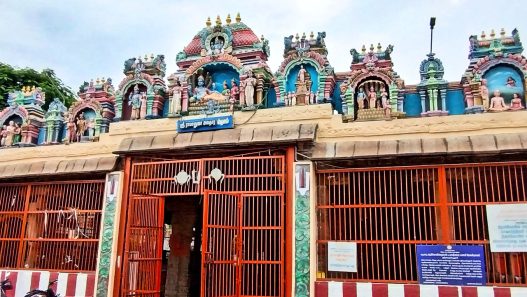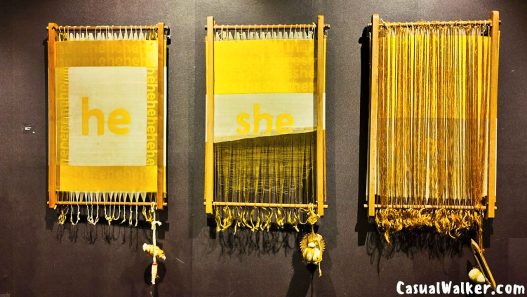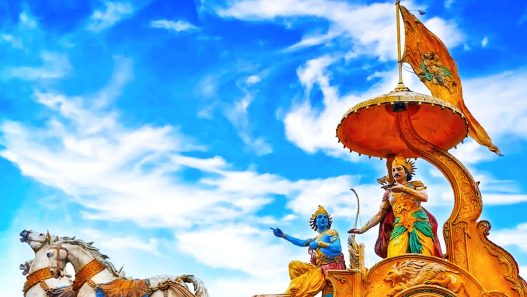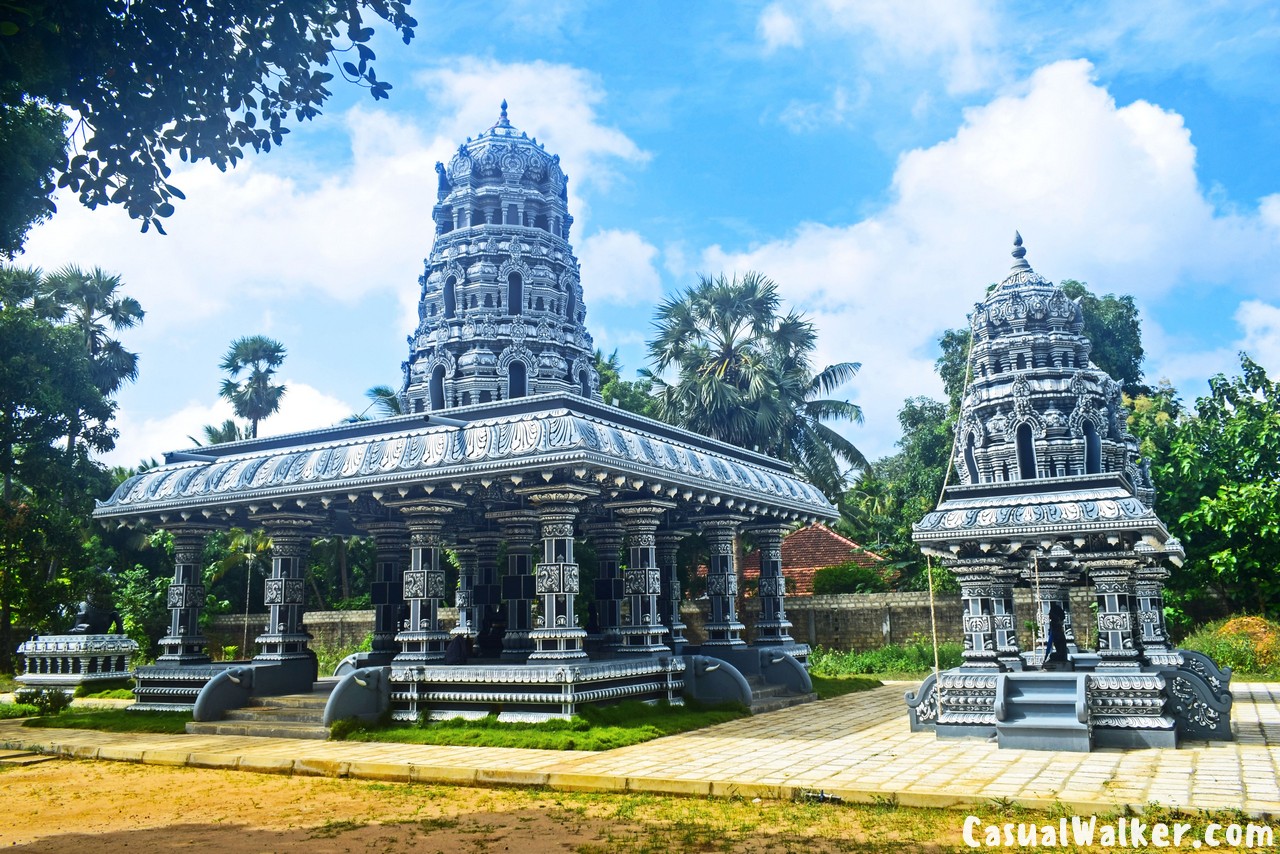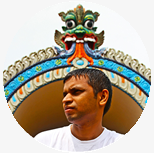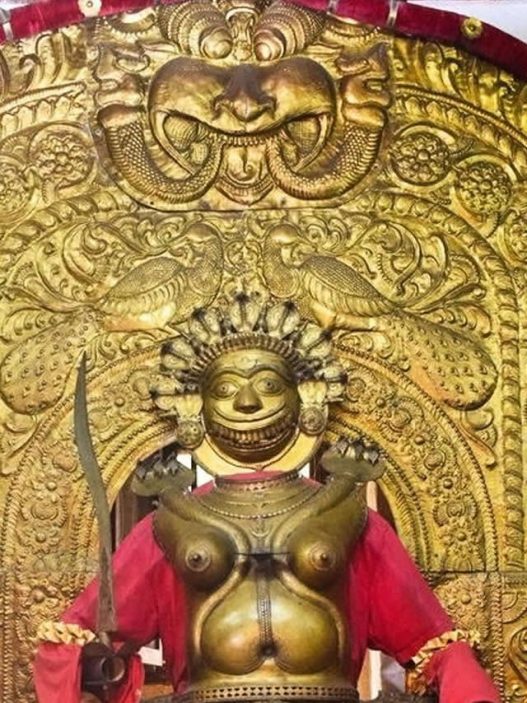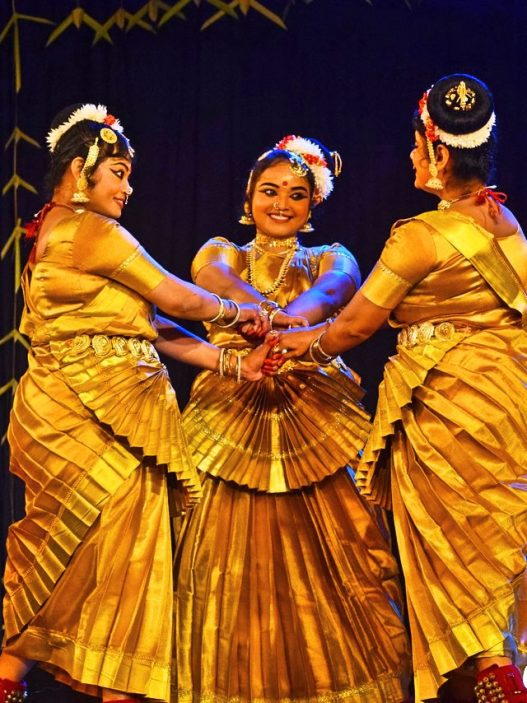Sri Subramuniya Temple & Ashram / Sri Pasupatheeswarar Temple in Alaveddy, Jaffna, Sri Lanka : A Living Tribute to Four Extraordinary Hindu Spiritual Lineage Gurus & Siddhars — Swami Sivaya Subramuniyaswami, Swami Kadaitswami, Swami Chellapaswami, Swami Yogaswami | Complete Visitor Guide, History, Visit Timings, Contact Details (Updated)
– experiencing the profound energy of hindu gurus
Sri Subramuniya Temple in Alaveddy, Jaffna, Sri Lanka is a sacred Sri Pasupatheeswarar Lord Shiva temple which represents a beautiful architecture and a living tribute to an extraordinary lineage of four spiritual masters and a beacon of spiritual practice in the Tamil Hindu diaspora. During my visits to this sacred Jaffna temple, I experienced firsthand the profound energy that permeates this sanctuary.

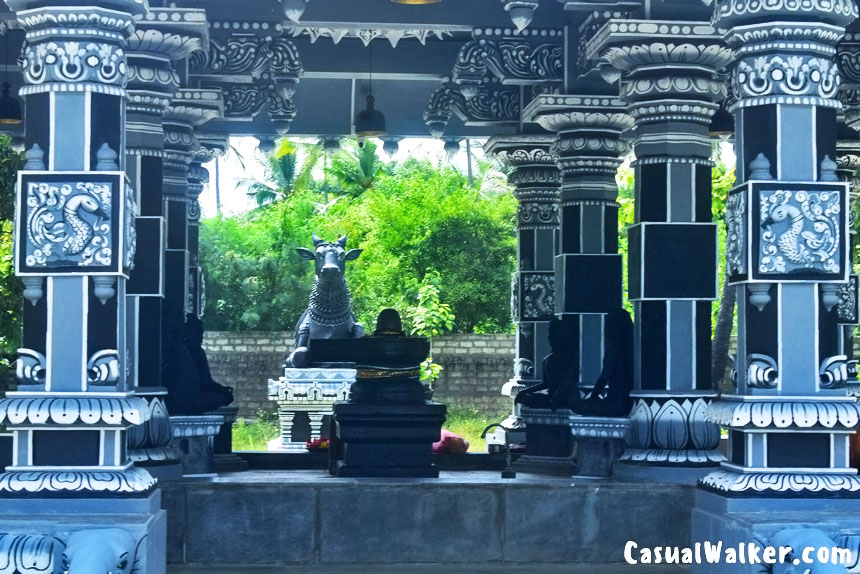
Sri Subramuniya Temple / Sri Pasupatheeswarar Temple and Its Sacred Presence
The Sri Subramuniya Temple / Sri Pasupatheeswarar Temple in Alaveddy is a marvel of spiritual intention and architectural simplicity. The structure is a square building with four entry doorways, representing accessibility and welcome from all directions.
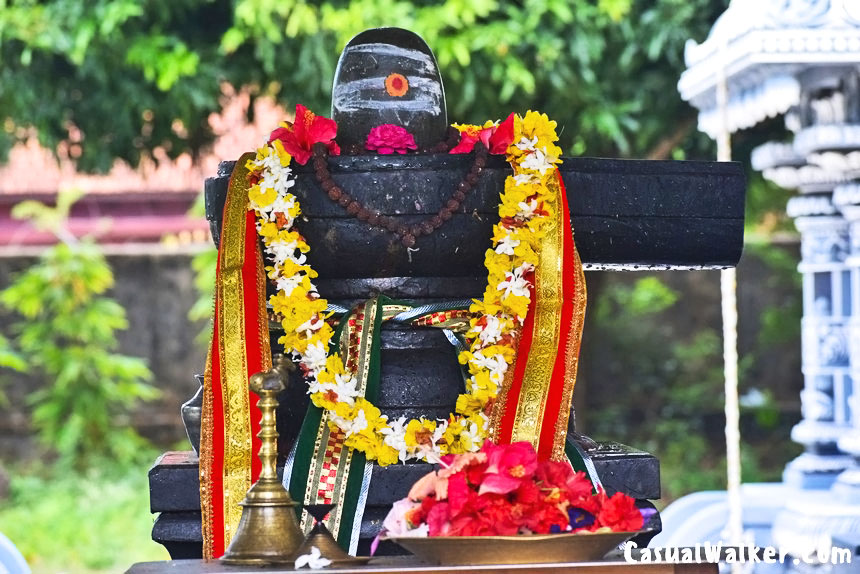
At its sacred center stands a beautifully installed Siva Lingam, the manifestation of the infinite, unchanging consciousness of Lord Shiva. A serene veranda surrounds the entire structure, creating a space for circumambulation and quiet reflection.
Another remarkable is the presence of a magnificent Nadi statue outside its sanctum. This powerful sculpture represents the sacred feminine energy and complements the Siva Lingam perfectly, embodying the complementary forces of masculine and feminine divinity.
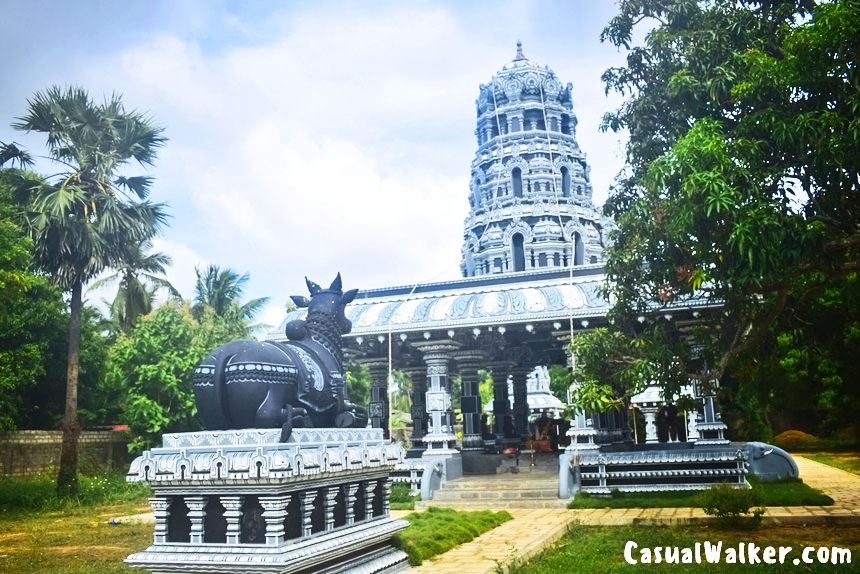
The Nadi statue is impressively large and carved with exquisite detail, drawing the eye and the heart of every devotee who enters. Standing before these two sacred representations—the Lingam and the Nadi—creates a profound sense of cosmic balance and completion.
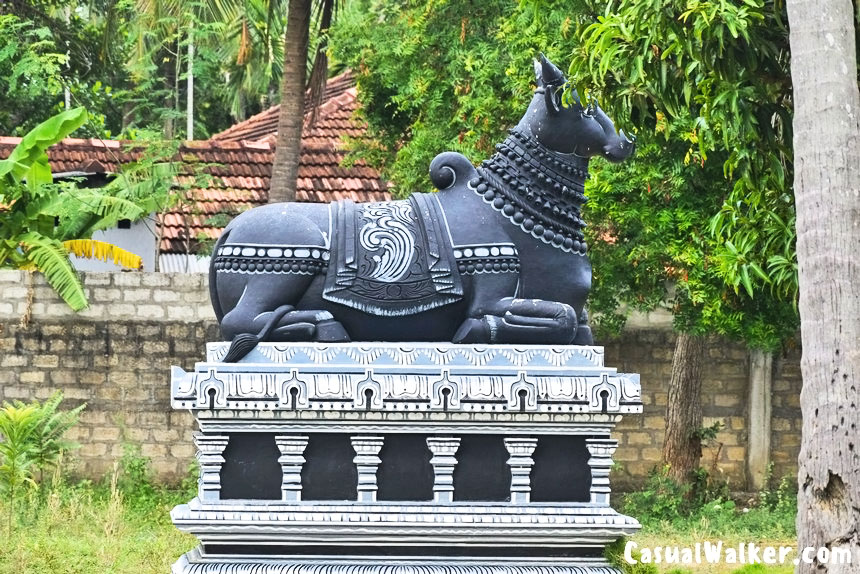

Spiritual Parampara – Lineage Gurus
Sacred murtis of each spiritual master are positioned at the four cardinal corners of the shrine room, creating a protective circle of enlightened consciousness around the sanctum. These four remarkable beings, living embodiments of divine realization, passed an eternal flame from hand to hand across generations, maintaining an unbroken chain of enlightenment that defied the conventions of time, culture, and geography.
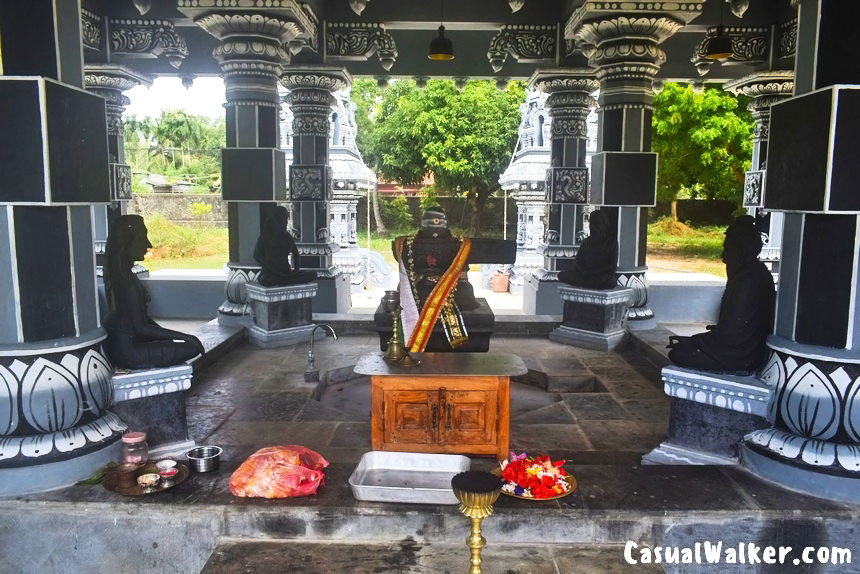
These divine representations of the Hindu spiritual parampara gurus—Swami Kadaitswami, Swami Chellapaswami, Swami Yogaswami, and Swami Shivaya Subramuniyaswami—stand as eternal guides and guardians, their spiritual presence blessing all who enter and establishing the Jaffna temple as a living connection to this unbroken lineage of realized teachers.
Mystery Walker: Swami Sri Kadaitswami (1820-1875)
Swami Sri Kadaitswami was born in the early decades of the 19th century when Sri Lanka still bore the colonial imprint of successive foreign powers, Kadaitswami rejected every vestige of civilized life to live as a pure avaduta, a God-intoxicated wanderer who recognized no law but the supremacy of divine consciousness. He used to sit beneath trees or in cremation grounds, while his eyes blazing with an inner fire that most mistook for insanity but which the spiritually awakened recognized as the mark of one who had merged completely with the Absolute.
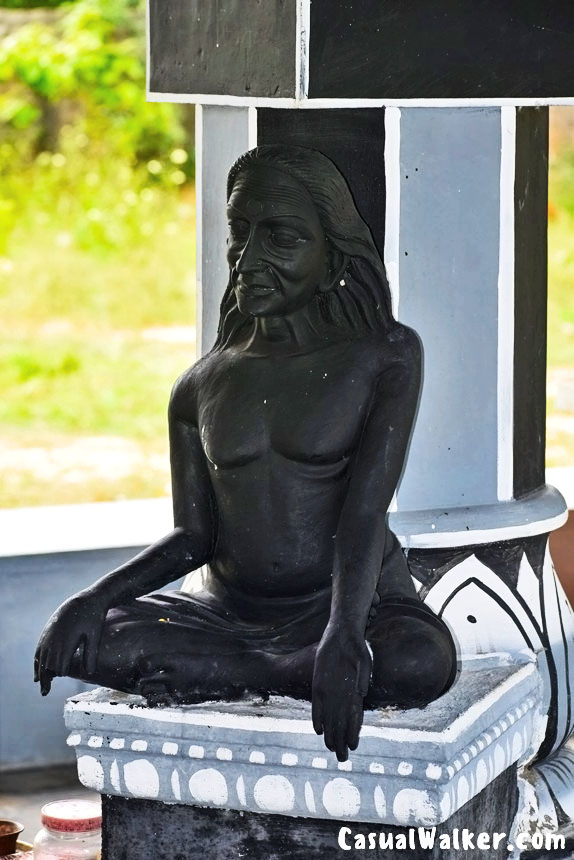
Unlike the scholarly swamis who debated philosophy in temples or the householder gurus who maintained ashrams, Kadaitswami owned nothing, wanted nothing, and acknowledged nothing of the social world. His teaching was brutal in its purity—he spoke rarely, and when he did, his words cut through illusion like a blade through silk. He communicated primarily through silence, through the overwhelming presence of his being, and through actions that appeared nonsensical to the uninitiated but carried the weight of cosmic truth to those with eyes to see.
Stories circulated of his miraculous powers: appearing in multiple places simultaneously, knowing the thoughts of those who approached him, manifesting objects from nowhere—yet he displayed such siddhis only accidentally, as natural expressions of a consciousness no longer bound by physical laws. What made Kadaitswami crucial to this lineage was not his powers but his preservation of an ancient transmission method, one that worked not through words or texts but through direct energetic transmission, guru to disciple, spirit to spirit. When he encountered the young man who would become Chellapaswami, he recognized immediately the soul prepared through countless lifetimes for this moment of awakening, and he set about destroying every last vestige of that young man’s separate self.
Silent Forge: Swami Sri Chellapaswami (1840s-1915)
Swami Sri Chellapaswami‘s transformation under Kadaitswami’s tutelage was nothing short of alchemical—a complete death and rebirth of consciousness. The man who emerged from years of harsh training bore little resemblance to the earnest seeker who had first approached the wild-haired master. Kadaitswami’s methods were severe: enforced silence that lasted for years, exposure to extreme heat and cold, deprivation of food and comfort, and sudden, inexplicable demands that made no sense to the rational mind. But beneath this apparent cruelty lay a precise spiritual science, a systematic dismantling of the ego-structure that allowed the infinite Self to shine forth unobstructed. When Chellapaswami finally received his guru’s blessing and the transmission of the lineage, he had become something more—and less—than human: a transparent channel for divine consciousness, his personal will so thoroughly surrendered that only God’s will remained.

Establishing himself in Columbuthurai after Kadaitswami’s passing around 1875, Chellapaswami continued his predecessor’s tradition but with his own unique flavor. His hermitage was a place of stark simplicity—a small hut, a few vessels, nothing more—yet it radiated a spiritual power that drew sincere seekers while repelling the merely curious. His presence was formidable; visitors reported feeling as though his gaze penetrated not just their thoughts but their very soul’s history across multiple incarnations. He spoke in brief, enigmatic phrases, often in classical Tamil, that operated like spiritual koans, bypassing the intellect to work directly on consciousness. “Ellam Ondre” (All is One) was among his signature teachings—a simple phrase that contained the entire non-dualistic philosophy of Saiva Siddhanta. He maintained the harsh standards of the lineage, testing those who came to him with apparent rejection, silence, or tasks that seemed pointless, sorting the truly committed from those seeking merely intellectual understanding or miraculous experiences.
What distinguished Chellapaswami’s era was his recognition that the lineage, while maintaining its purity, needed to prepare for a changing world. The British colonial presence was transforming Sri Lankan society; Western education was spreading; the old ways were being challenged. Yet Chellapaswami remained rooted in the ancient tradition, trusting that the right successor would appear at the right time. That trust was vindicated when a young man named Sadasivan began visiting him in the early 1900s. In this government surveyor who harbored a secret spiritual fire, Chellapaswami saw the bridge to the future—someone educated in modern ways yet hungry for traditional wisdom, someone who could speak to both worlds. The transmission he gave to Yogaswami would prove to be one of the most consequential guru-disciple initiations in modern Hindu history.
Singing Saint: Swami Sri Siva Yogaswami (1872-1964)
Swami Sri Siva Yogaswami represented a departure from his predecessors while maintaining their essential realization. Born in 1872 into a world where ancient Tamil culture collided with British modernity, young Sadasivan lived a double life—externally a competent colonial surveyor, internally a seeker consumed by spiritual questions. He studied various philosophies, read the works of Tamil saints like Thayumanavar and Pattinathar obsessively, and practiced intense devotional worship. But intellectual study and devotional fervor alone could not provide what he desperately sought: direct experience of the Self.
When he finally found his way to Chellapaswami’s hermitage, the transmission was immediate and dramatic. According to legend, Chellapaswami struck the young man forcefully on the back, and in that instant, Sadasivan’s kundalini energy awakened with such force that he was catapulted into samadhi. What followed were years of intensive training during which Chellapaswami systematically guided his disciple into the permanent establishment of Self-realization.
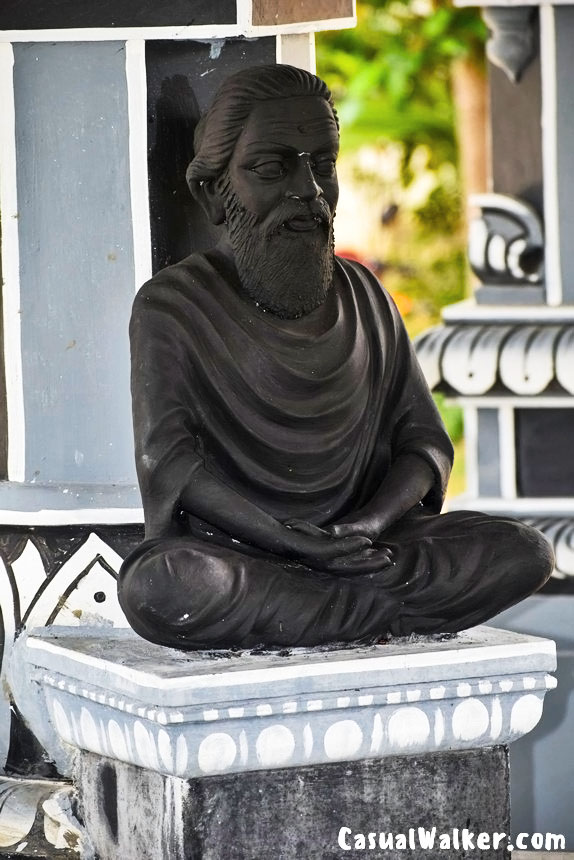
The Yogaswami who emerged from this crucible was a unique synthesis of ancient and modern. He maintained the fierce, uncompromising stance of his lineage—capable of terrifying rebukes, sudden tests, and apparent rejection of even devoted disciples. Yet he was also more accessible than his predecessors, allowing larger numbers of people to visit, engaging in longer conversations, and expressing his realization through spontaneous Tamil poetry that flowed from him in states of divine intoxication. His small hut in Columbuthurai became a pilgrimage destination where the boundaries between the sacred and mundane dissolved. He might be found singing ecstatic songs one moment, providing practical advice to a struggling farmer the next, entering deep samadhi the following moment, and then suddenly roaring at someone whose ego needed shattering. His famous teaching “Summa iru”—”Be still”—encapsulated the direct path he taught: not elaborate practices or complex philosophies, but the simple, profound act of quieting the mind’s restless activity to discover the eternal Self that was always already present.
Yogaswami‘s prophetic abilities became legendary throughout Sri Lanka. People reported that he would answer questions before they were asked, provide detailed information about events occurring hundreds of miles away, and offer guidance that proved uncannily accurate years later. Yet he consistently deflected attention from such phenomena, insisting they were merely side effects of Self-realization, not its goal. He emphasized that liberation was not something to be achieved in some distant future but was the ever-present reality of one’s own being, obscured only by the mind’s habitual patterns of thought and identification. His teaching method was highly individualized—some he showered with affection, others he seemed to ignore completely, still others he subjected to harsh criticism—yet each received exactly what their spiritual evolution required. His spontaneous songs, later compiled in the collection “Natchintanai,” reveal a consciousness intoxicated with divine love, expressing the ineffable mysteries of Saiva Siddhanta in language both simple and profound. Lines like “Thannai ariye” (Know the Self) and “Ellam Sivamayam” (Everything is Siva) became mantras for thousands of devotees.
Golden Bridge: Swami Satguru Sri Sivaya Subramuniyaswami (1927-2001)
The lineage’s most dramatic transformation came through Yogaswami’s recognition of a young American seeker named Robert Hansen. Born in 1927 in Oakland, California, Hansen seemed an unlikely successor to a lineage of Tamil siddhas stretching back into ancient times. Yet spiritual awakening follows no predictable pattern. At age 22, while studying ballet and living a bohemian artistic life in San Francisco, Hansen experienced a spontaneous, overwhelming realization of the Self—a cosmic consciousness experience that left him fundamentally transformed. This awakening created an irresistible pull toward India and its spiritual traditions. In 1949, following an inner compulsion he could not deny, he traveled to Sri Lanka and found his way to Yogaswami’s hut in Columbuthurai.

The meeting of guru and disciple was recognition at the deepest level. Yogaswami immediately saw in this young Westerner the destined vessel for carrying the Nandinatha Sampradaya beyond the Tamil world into global consciousness. He did not ask Hansen to become Tamil or Sri Lankan; instead, he recognized that the eternal truths of Saiva Siddhanta could be expressed through any cultural form. The training that followed was intensive—periods of deep instruction alternating with apparent neglect, sudden transmissions of spiritual energy, cryptic statements whose meaning would only become clear years later, and above all, the overwhelming presence of a fully realized master whose very being served as a constant initiation. Yogaswami gave Hansen the name Sivaya Subramuniyaswami and a mission that was both daunting and exhilarating: establish the teachings of Saiva Siddhanta in the Western world, adapt the ancient monastic tradition for modern seekers, and maintain the purity of the lineage while making it accessible to contemporary consciousness.
Subramuniyaswami returned to the West as something unprecedented: a Western satguru in an authentic Eastern lineage. He established the Saiva Siddhanta Church in 1957, initially in San Francisco, navigating the challenges of transplanting an ancient tradition into the soil of mid-20th-century America. The 1960s and 70s brought both opportunities and obstacles—a generation of spiritual seekers hungry for authentic teaching, but also the confusion of diluted or commercialized spirituality. Subramuniyaswami maintained uncompromising standards, establishing genuine monastic training for Western men willing to embrace lifelong celibacy, renunciation, and service. In the early 1970s, he made the bold decision to relocate his monastery to the Hawaiian island of Kauai, where he would establish not just a monastery but a complete Hindu ecosystem: the Kadavul Hindu Temple for daily worship, the magnificent San Marga Iraivan Temple carved entirely from granite quarried in India, and the Himalayan Academy as a publishing and educational institution.
What set Subramuniyaswami apart was his unique ability to honor tradition while embracing innovation. He understood that for Saivism to flourish in the modern world, it needed contemporary expression. He became a prolific writer, producing comprehensive texts like “Dancing with Siva,” “Living with Siva,” and “Merging with Siva“—trilogies that systematically presented the philosophy, culture, and spiritual practices of Saiva Siddhanta in clear, accessible English without diluting their depth. In 1979, he founded Hinduism Today magazine, which became a globally respected voice for Hindu perspectives on contemporary issues. He embraced technology early, using computers, desktop publishing, and eventually the internet to spread teachings that had traditionally been passed only orally from guru to disciple. He trained monks in meditation, philosophy, and also in practical skills—publishing, web development, temple management—creating a monastic model that was both ancient and contemporary.
Subramuniyaswami’s influence extended far beyond his immediate students. He was a pioneer in Hindu-Christian dialogue, in articulating Hindu perspectives in pluralistic societies, and in defending Hinduism against misrepresentation while building bridges with other faiths. He served as one of the founding members of the World Council of Religious Leaders and was recognized globally as an authentic spokesman for traditional Hinduism. He made regular pilgrimages back to Sri Lanka, maintaining his connection with Yogaswami until the master’s mahasamadhi in 1964, and continued to visit sacred sites throughout India and Asia. His own monastery on Kauai became a pilgrimage destination, where visitors could experience living Saivism in practice—daily pujas, fire ceremonies, monks in traditional dress, yet all conducted in English and accessible to anyone sincere, regardless of birth or background.
The Eternal Flame
When Subramuniyaswami attained mahasamadhi on November 12, 2001, he left behind a remarkable legacy: a thriving monastic community, temples that would serve generations, publications that had reached millions, and—most importantly—the living transmission of the Nandinatha Sampradaya firmly established in the Western world. Before his passing, he carefully prepared his successor, Satguru Bodhinatha Veylanswami, ensuring the lineage would continue unbroken. The story of these four masters—Kadaitswami, Chellapaswami, Yogaswami, and Sivaya Subramuniyaswami—demonstrates a profound truth: authentic spiritual realization transcends all boundaries of culture, race, and time. What began in the mysterious forests and cremation grounds of 19th-century Sri Lanka found full flowering in 21st-century Hawaii, not through compromise or dilution, but through the recognition that Self-realization speaks a universal language that adapts its accent while never changing its essential message.
Each of these four siddhas embodied the same truth in different forms. Kadaitswami’s wild renunciation, Chellapaswami’s austere silence, Yogaswami’s singing enlightenment, and Subramuniyaswami’s articulate teaching all pointed to the same moon—the eternal Self, ever-present, ever-free, waiting to be recognized beneath the surface noise of the mind. Their lineage continues today, a golden thread connecting ancient Hindu wisdom with contemporary seekers worldwide, proving that the fire of enlightenment, once truly kindled, can never be extinguished but only passed from flame to flame, generation to generation, burning away ignorance and illuminating the path home.
Lord Murugan and Lord Ganesha Shrines
The Alaveddy temple also houses sacred shrines dedicated to Lord Murugan and Lord Ganesha, honoring the divine family of Lord Siva. This shrine draws devotees seeking strength, protection, and spiritual guidance on their path.
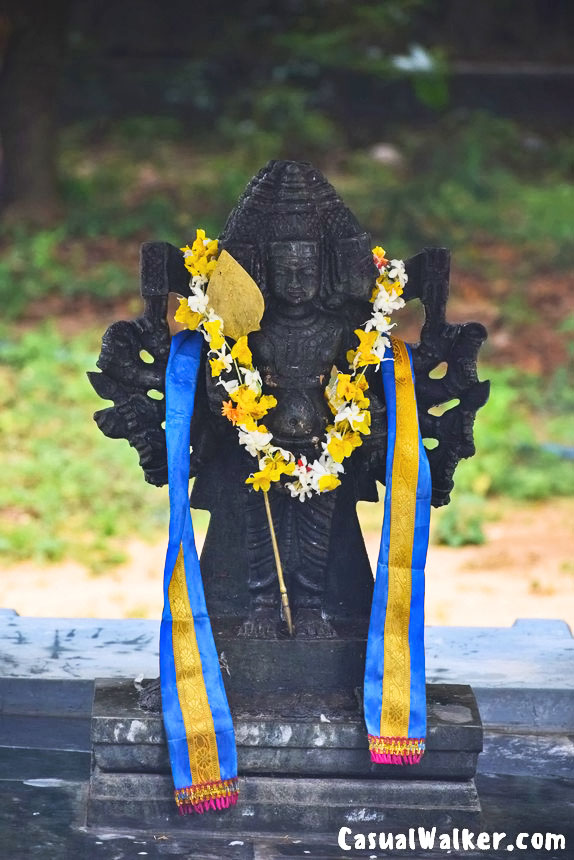
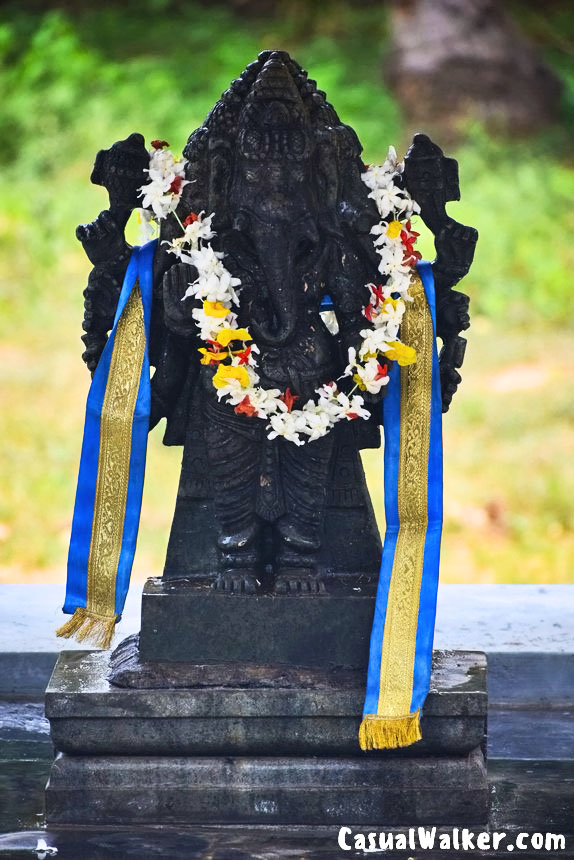
The presence of these beloved deities alongside the central Siva Lingam creates a complete expression of Hindu cosmology—honoring the supreme consciousness of Lord Shiva while acknowledging the multifaceted expressions of the divine that guide and protect all seekers.
Main Festivals at Sri Subramuniya Temple & Ashram
Sri Pasupatheeswarar Temple / Sri Subramuniya Temple & Ashram celebrates two major festivals each year. Maha Shivratri, the great night of Lord Shiva, is observed with grand festivities. Additionally, the temple honors the guru purnima of its four distinguished gurus in the Nandinatha Sampradaya lineage — Swami Sivaya Subramuniyaswami, Swami Kadaitswami, Swami Chellapaswami, and Swami Yogaswami — commemorating their spiritual legacy with devotion and reverence.
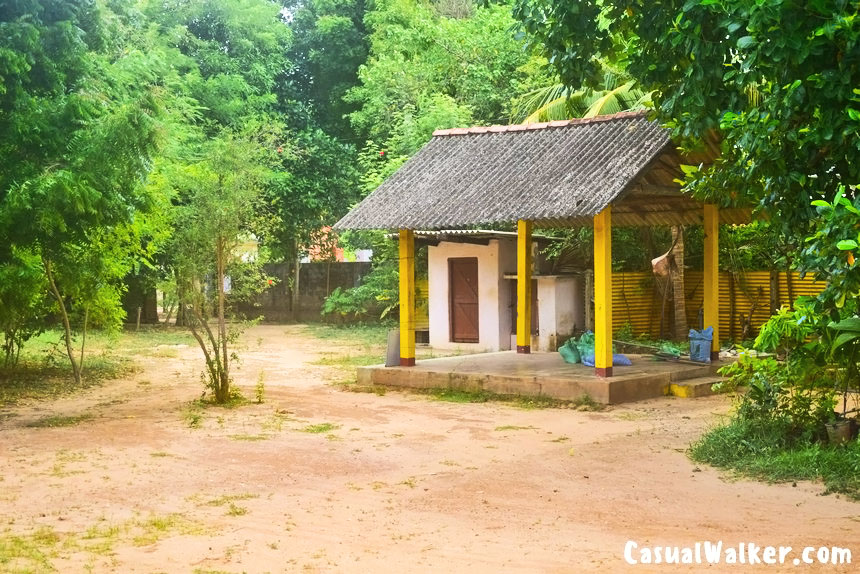
Experiencing the Temple’s Spiritual Energy
What struck me most during my time at this Alaveddy Hindu temple was the overwhelming stillness and peace. This is one of the most meditative spaces I have encountered, where the powerful spiritual energy feels almost tangible. The combination of the ancient guru lineage murtis at the four corners, the sacred Siva Lingam at the center, and the majestic Nadi statue creates a vortex of spiritual consciousness. Whether you come to worship, meditate, or simply sit in silence, this temple offers a refuge for inner uplift and profound peace.

Supporting the Temple’s Spiritual and Social Mission
Gurudeva’s vision for this sacred space continues through the dedication of community members and the ongoing spiritual work of his successors. The Sri Subramunya Temple / Sri Pasupatheeswarar Temple in Alaveddy is far more than a place of worship—it is a beacon of spiritual and social service, actively uplifting the Jaffna community through religious education, cultural programs, and social initiatives.

It also as a living embodiment of the guru parampara—a tangible connection to centuries of enlightened masters. If you’re interested in supporting this noble project or planning a visit to this sacred Jaffna temple, you can reach out to Swami Rishi Thondunathan, who heads and coordinates the temple’s spiritual and social works and can arrange accommodations at the guest house for devotees from around the world.



Travel Tips for Visiting Sri Subramuniya Temple & Ashram / Sri Pasupatheeswarar Temple in Alaveddy, Jaffna
Address of Sri Subramuniya Temple & Ashram / Sri Pasupatheeswarar Temple in Alaveddy, Jaffna:
Sri Subramuniyaya Temple
Q2F6+4RF, Alaveddy, Sri Lanka
Temple Opening Timings:
Morning: 8:00 AM – 12:00 PM
Evening: 4:00 PM – 6:00 PM
Daily Pooja Time: Morning 9:00 AM
Donate to Subramuniyaya Temple Fund:
https://www.hheonline.org/funds/fund_35.html
Contact Person: Swami Rishi Thondunathan
Phone: +94779866328 / +94779866328
How to Visit Sri Subramuniya Temple & Ashram / Sri Pasupatheeswarar Templein Alaveddy, Jaffna
By Bus: Long-distance buses operate from Colombo to Jaffna Central Bus Station, with various comfort levels available—luxury, semi-luxury, express, and local buses. The journey takes 8-10 hours depending on traffic and stops, with costs ranging from LKR 500–1,500. Buses depart from Bastian Mawatha Bus Terminal in Colombo. Once in Jaffna, take a local taxi to Alaveddy.
By Private Taxi or Car Hire: Hire a private taxi or chauffeur-driven car for door-to-door service from Colombo Airport. The journey takes 7-8 hours and costs LKR 15,000–35,000 (USD 75–150). English-speaking drivers are available, and you can make stops along the way at scenic locations.
Local Transport to Alaveddy: Once you reach Jaffna city, you can hire a local taxi or tuk-tuk (auto-rickshaw) to reach Alaveddy village, which is located in the Jaffna district. The distance is relatively short, and locals can easily direct you to the Sri Subramuniya Temple in Alaveddy.
By Train: Take a direct train from Colombo Fort to Jaffna operated by Sri Lanka Railways. The journey takes 8-9 hours and costs LKR 500–2,000 depending on the class. First-class air-conditioned carriages offer more comfort. Three trains operate daily, and booking in advance is recommended. From Jaffna railway station, hire a local taxi to reach Alaveddy.
By Flight: Fly from Colombo Bandaranaike Airport (CMB) to Jaffna’s Palaly Airport (JAF) on domestic flights operated by SriLankan Airlines or FitsAir. The flight takes approximately 60 minutes and costs around LKR 8,000–15,000 (USD 40–75) one-way. Once you arrive in Jaffna, you can hire a local taxi or arrange transport to Alaveddy, which is about 30-45 minutes from the airport.


